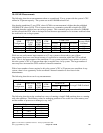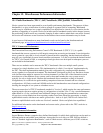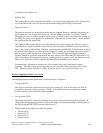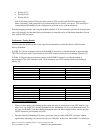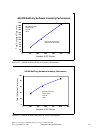
less CPU utilization resulting in slightly lower transaction rates and slightly longer response times.
However, the batch job gets more CPU utilization and consequently shorter run time.
y It is recommended that you run with Dynamic Priority Scheduling for optimum distribution of
resources and overall system performance.
For additional information, refer to the Work Management Guide.
19.3 Main Storage Sizing Guidelines
To take full advantage of the performance of the new AS/400 Advanced Series using PowerPC
technology, larger amounts of main storage are required. To account for this, the new models are
provided with substantially more main storage included in their base configurations. In addition, since
more memory is required when moving to RISC, memory prices have been reduced.
The increase in main storage requirements is basically due to two reasons:
y When moving to the PowerPC RISC architecture, the number of instructions to execute the same
program as on CISC has increased. This does not mean the function takes longer to execute, but it
does result in the function requiring more main storage. This obviously has more of an impact on
smaller systems where fewer users are sharing the program.
y The main storage page size has increased from 512 bytes to 4096 bytes (4KB). The 4KB page size is
needed to improve the efficiency of main storage management algorithms as main storage sizes
increase dramatically. For example, 4GB of main storage will be available on AS/400 Advanced
System model 530.
The impact of the 4KB page size on main storage utilization varies by workload. The impact of the
4KB page size is dependent on the way data is processed. If data is being processed sequentially, the
4KB page size will have little impact on main storage utilization. However, if you are processing
data randomly, the 4KB page size will most likely increase the main storage utilization.
19.4 Memory Tuning Using the QPFRADJ System Value
The Performance Adjustment support (QPFRADJ system value) is used for initially sizing memory pools
and managing them dynamically at run time. In addition, the CHGSHRPOOL and WRKSHRPOOL
commands allow you to tailor memory tuning parameters used by QPFRADJ. You can specify your own
faulting guidelines, storage pool priorities, and minimum/maximum size guidelines for each shared
memory pool. This allows you the flexibility to set unique QPFRADJ parameters at the pool level.
For a detailed discussion of what changes are made by QPFRADJ, see the Work Management Guide.
What follows is a description of some of the affects of this system value and some discussion of when the
various settings might be appropriate.
When the system value is set to 1, adjustments are made to try to balance the machine pool, base pool,
spooling pool, and interactive pool at IPL time. The machine pool is based on the amount of storage
needed for the physical configuration of the system; the spool pool is fairly small and reflects the number
IBM i 6.1 Performance Capabilities Reference - January/April/October 2008
© Copyright IBM Corp. 2008 Chapter 19 - Misc Perf Information 306




